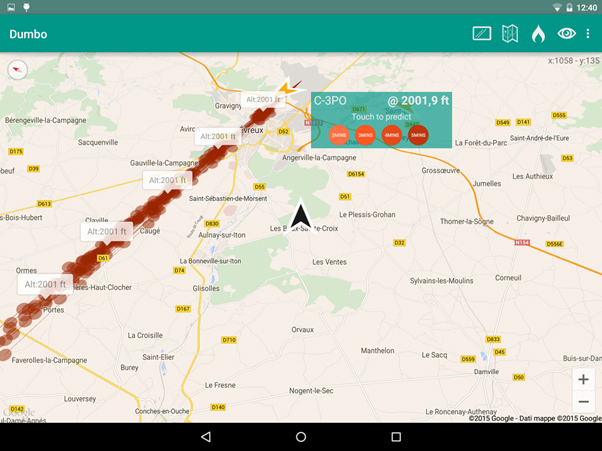A recently completed SESAR exploratory research project, ProGA, has investigated a solution to improve the situational awareness of pilots flying General Aviation (GA) light aircraft in high traffic densities. The project consortium has developed a prototype human machine interface and tablet application supplying traffic statistics, and has issued a series of recommendations for further research in this field.
In GA, pilots flying small aircraft rely on visual flight rules, meaning they must constantly look in all directions to spot and take steps to avoid surrounding traffic - In general, no separation services are provided to these aircraft by air traffic control. While it is true that collision rates in GA have remained stable over the past decade, there is a growing interest in finding tools to further enhance safety in this field of aviation.
Led by NLR in cooperation with Deep Blue and Onera, the ProGA project studied a technological solution to provide pilots of light aircraft with traffic statistics for flight planning purposes and an in-flight electronic representation of the estimated future location of surrounding traffic. The provision of traffic statistics during flight planning aimed to facilitate decision making, and improve the pilot’s awareness of areas with high traffic densities in advance of the flight. Meanwhile, the provision of estimated locations of surrounding traffic in-flight aimed to increase the situational awareness of the pilot and improve predictability of areas with high traffic densities during flight.
The research focused on the ability to estimate the future position of GA traffic based on information on the typical behaviour of GA pilots and the intent of their flights. An important starting point was safeguarding the key characteristics of GA: affordable equipment, limited complexity of procedures and freedom of flight.
The ProGA solution
The proposed solution (see Figure 1) involves the use of satellite navigation systems, which allow the route taken by GA aircraft to be logged and analysed. The system processes the flight tracks to obtain a statistical characterisation of typical GA behaviour – “GA recurring patterns”. During the in-flight phase, the system estimates aircraft positions and ground speeds of surrounding traffic. These state-based predictions can be compared to the recurring patterns and shared flight intent, if available, to support longer-term intent-based prediction. Three functionalities are provided to a GA pilot using the ProGA solution:
- A pre-flight presentation of areas with a significant probability of high traffic density, derived from the statistical characterisation of GA recurring patterns, and, if available, declared flight intents.
- An in-flight display of areas with a significant probability of high traffic density.
- An in-flight display of traffic, including predicted future positions. These predictions are shown as flight corridors.

Figure 1 - Outline of the ProGA prediction concept
Key results and future steps
A ProGA prototype has been developed, consisting of a flight simulator, a unit which generates flight corridor predictions, and a tablet application which is able to provide the pilot with these predictions. The main component of ProGA’s user-interface includes a moving map on which the own-ship (black arrow) and the surrounding traffic (yellow arrow) are displayed (see Figure 2). The predicted flight corridor is displayed on the map.
The introduction of ProGA functionalities gives a pilot the necessary tools to improve strategic conflict management, enhanced situational awareness, and an increased horizon to resolve conflicts. The idea of providing GA pilots with advanced traffic information is thought to have benefits that warrant further research.
The pilot acceptance of the concept, including sharing of flight intent and the tracks of GA flights for analysis, requires further study. There is also a need to determine how many flight tracks need to be processed to acquire useable statistical information on typical GA behaviour. The human machine interface needs to be further developed. Lastly, there is a need to study liability issues linked to the provision of safety sensitive information that a GA pilot can use for decision making.

Figure 2 - Prototype human-machine interface for ProGA, including a predicted flight corridor
